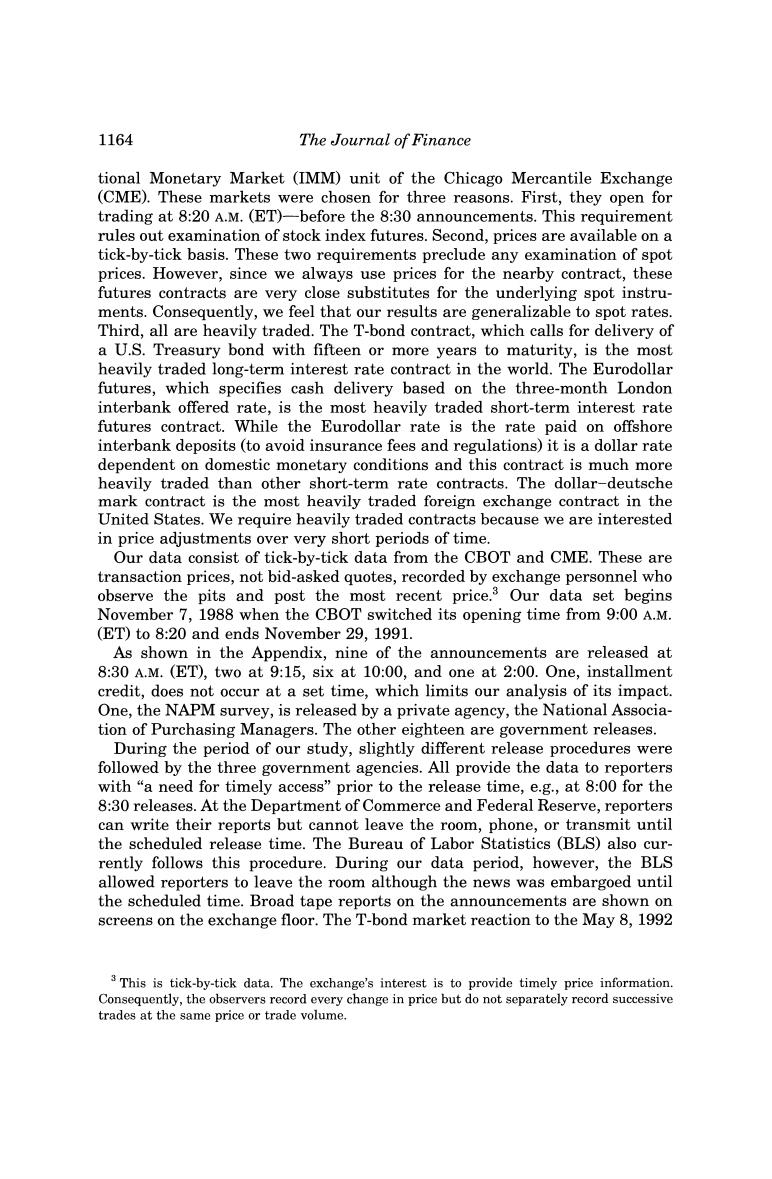正在加载图片...

1164 The Journal of Finance tional Monetary Market (IMM)unit of the Chicago Mercantile Exchange (CME).These markets were chosen for three reasons.First,they open for trading at 8:20 A.M.(ET)-before the 8:30 announcements.This requirement rules out examination of stock index futures.Second,prices are available on a tick-by-tick basis.These two requirements preclude any examination of spot prices.However,since we always use prices for the nearby contract,these futures contracts are very close substitutes for the underlying spot instru- ments.Consequently,we feel that our results are generalizable to spot rates. Third,all are heavily traded.The T-bond contract,which calls for delivery of a U.S.Treasury bond with fifteen or more years to maturity,is the most heavily traded long-term interest rate contract in the world.The Eurodollar futures,which specifies cash delivery based on the three-month London interbank offered rate,is the most heavily traded short-term interest rate futures contract.While the Eurodollar rate is the rate paid on offshore interbank deposits(to avoid insurance fees and regulations)it is a dollar rate dependent on domestic monetary conditions and this contract is much more heavily traded than other short-term rate contracts.The dollar-deutsche mark contract is the most heavily traded foreign exchange contract in the United States.We require heavily traded contracts because we are interested in price adjustments over very short periods of time. Our data consist of tick-by-tick data from the CBOT and CME.These are transaction prices,not bid-asked quotes,recorded by exchange personnel who observe the pits and post the most recent price.3 Our data set begins November 7,1988 when the CBOT switched its opening time from 9:00 A.M. (ET)to 8:20 and ends November 29,1991. As shown in the Appendix,nine of the announcements are released at 8:30 A.M.(ET),two at 9:15,six at 10:00,and one at 2:00.One,installment credit,does not occur at a set time,which limits our analysis of its impact. One,the NAPM survey,is released by a private agency,the National Associa- tion of Purchasing Managers.The other eighteen are government releases. During the period of our study,slightly different release procedures were followed by the three government agencies.All provide the data to reporters with "a need for timely access"prior to the release time,e.g.,at 8:00 for the 8:30 releases.At the Department of Commerce and Federal Reserve,reporters can write their reports but cannot leave the room,phone,or transmit until the scheduled release time.The Bureau of Labor Statistics (BLS)also cur- rently follows this procedure.During our data period,however,the BLS allowed reporters to leave the room although the news was embargoed until the scheduled time.Broad tape reports on the announcements are shown on screens on the exchange floor.The T-bond market reaction to the May 8,1992 3 This is tick-by-tick data.The exchange's interest is to provide timely price information. Consequently,the observers record every change in price but do not separately record successive trades at the same price or trade volume